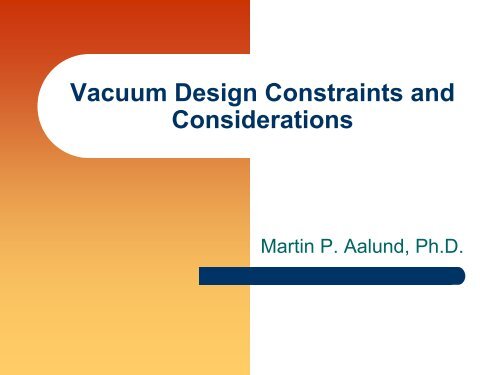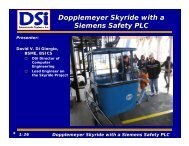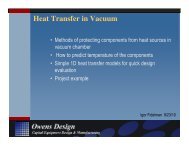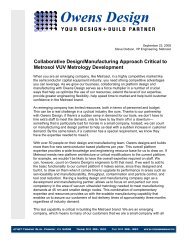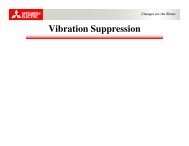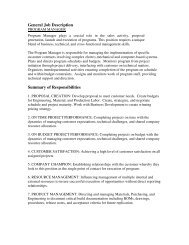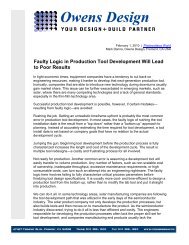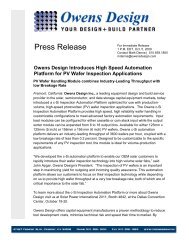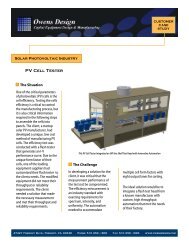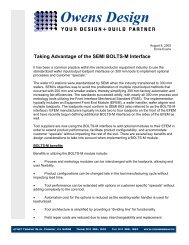Vacuum Design Constraints and Considerations - Owens Design
Vacuum Design Constraints and Considerations - Owens Design
Vacuum Design Constraints and Considerations - Owens Design
Create successful ePaper yourself
Turn your PDF publications into a flip-book with our unique Google optimized e-Paper software.
<strong>Vacuum</strong> <strong>Design</strong> <strong>Constraints</strong> <strong>and</strong><br />
<strong>Considerations</strong><br />
Martin P. Aalund, Ph.D.
Summary<br />
• Intro to <strong>Vacuum</strong> Technology<br />
– History<br />
– Terminology<br />
– Levels of <strong>Vacuum</strong>s<br />
– Cluster Tools<br />
• The <strong>Vacuum</strong> barrier, How do you Cross it?<br />
– Robotics<br />
– Motion Across The Barrier<br />
– Data <strong>and</strong> Electrically<br />
• <strong>Design</strong> Consideration<br />
– How do we Maintain it<br />
– Virtual Leaks<br />
– Material Compatibility<br />
• Out gassing
Intro to <strong>Vacuum</strong> Technology<br />
• History<br />
• Why do we need <strong>Vacuum</strong>s<br />
• Terminology<br />
• Levels of <strong>Vacuum</strong>s<br />
• Cluster Tools<br />
• Robots
<strong>Vacuum</strong> History<br />
• Evangelista Torricelli was the first person credited with creating<br />
a vacuum 1643 <strong>and</strong> also invented the barometer. This was in<br />
an attempt underst<strong>and</strong> why a suction pump could only raise<br />
water to 32 feet.<br />
• Robert Boyle (1627-1691) used a von Guericke pump,<br />
improved by the young Robert Hooke, to investigate the<br />
vacuum <strong>and</strong> the general properties of gases <strong>and</strong> gas pressure<br />
• Engl<strong>and</strong>. Papin invented the Pressure Cooker<br />
• Currently one of the most impressive bits of artificial emptiness<br />
is created in the particle accelerators. The large electronpositron<br />
collider (LEP) at CERN gets down to a pressure of 10-<br />
12 Torr or 1.3*10-10 Pa This corresponds to a particle density<br />
of about 1011 hydrogen molecules per cubic meter.<br />
• To a first approximation the average density of the universe is<br />
about 1 hydrogen atom per m3
Why do we need <strong>Vacuum</strong><br />
• Limits Contamination<br />
– No Airborne Contamination<br />
– Limits Cross Contamination<br />
• Control Chemistries<br />
– Slows Oxidation<br />
– Allows for Controlled Atmospheres<br />
• Many process can be made more predictable or require a vacuum to<br />
function<br />
– Plasma Production<br />
– Metallization: Metal is evaporated <strong>and</strong> deposited onto a substrate<br />
– Etch<br />
– Deposition<br />
– Sputtering<br />
– Ion Implantation<br />
– E-beam<br />
• Metrology<br />
• Inspection
Terminology<br />
• <strong>Vacuum</strong>:<br />
– A volume of Space Substantially void of matter<br />
(Wikepedia)<br />
– a space partially exhausted (as to the highest<br />
degree possible) by artificial means (as an air<br />
pump) (Websters)<br />
• Manometer: Liquid scale used to measure<br />
vacuum or pressure usually in Inches or mm<br />
• torr: A unit of measurement for pressure:<br />
torr<br />
= 1mm_Hg torr = 1.32× 10 − 3 atm<br />
P 1<br />
P 2<br />
∆P<br />
torr<br />
= 0.039in_Hg torr = 133.32Pa<br />
• (it is named after Evangelista Torricelli)<br />
• Virtual Leek: A void or trapped volume that<br />
slowly released material into a vacuum.<br />
Examples include Blind wholes with screws etc.
Terminology<br />
• Atmospheric pressure is variable based on weather <strong>and</strong> location, but is<br />
st<strong>and</strong>ardized at 101.325 kPa (760 Torr)<br />
• Low vacuum, also called rough vacuum or coarse vacuum, is vacuum that can<br />
be achieved or measured with rudimentary equipment such as a household<br />
vacuum cleaner. Can be measure with a simple manmometer<br />
• Medium vacuum is vacuum that can be achieved with a single pump, but is<br />
too low to measure with a liquid or mechanical manometer. It can be measured<br />
with a McLeod gauge, thermal gauge or a capacitive gauge.<br />
• High vacuum is vacuum where the mean free path of residual gases is longer<br />
than the size of the chamber or of the object under test. High vacuum usually<br />
requires multi-stage pumping <strong>and</strong> ion gauge measurement. Some texts<br />
differentiate between high vacuum <strong>and</strong> very high vacuum.<br />
• Ultra high vacuum requires baking the chamber to remove trace gases, <strong>and</strong><br />
other special procedures.<br />
• Deep space is generally much more empty than any artificial vacuum that we<br />
can create. But it is not uniform <strong>and</strong> has areas of gas that may be quite dense.<br />
• Perfect vacuum is an ideal state that cannot be obtained in a lab, nor even in<br />
outer space.<br />
• AMC: Airborne Molecular Contaminates: Gaseous Atoms, Molecules, or<br />
clusters
AMCs<br />
• Can be emitted from Cables, Plastic or Electrometric Parts<br />
• Airborne molecular Include<br />
– Acids: HCl, HF, SO x , NO x , etc.<br />
– Basis: Amonias: Amines, etc<br />
– Condensates: Phthalic Ester, Siloxane, Etc<br />
– Dopants: Boron, Phosphorous<br />
• AMC Related Problems include<br />
– Yield Loss<br />
– Corrosion of metal surfaces on the wafer<br />
– Surface Pollution<br />
• Haze on wafers<br />
• Haze on optics<br />
– Changes in contact resistance<br />
• AMC Control<br />
– Use materials with High Molecular weight <strong>and</strong> Low Volatility<br />
– Use High Purity Materials<br />
– Control Cross Contamination during Manufacturing <strong>and</strong> Installation<br />
• Outgassing Measurements<br />
– Testing is performed in vacuum. Sample from 100 to 300 grams in placed in special aluminum boat<br />
<strong>and</strong> heated to 398K inside a copper container with a 6.3 mm hole for 24 hours. A Chromium plated<br />
disk is placed in front of a 6.3 mm hole.<br />
– TML Total Mass Loss<br />
– CVCM Collected Volatile Condensable Material<br />
– WVR Water Vapor Regained (Exposed to 50% Humidity for 24 Hours)
Levels of <strong>Vacuum</strong><br />
Name<br />
Atmospheric Pressure (variable)<br />
Low, Rough or Course <strong>Vacuum</strong><br />
Medium <strong>Vacuum</strong><br />
High <strong>Vacuum</strong><br />
Ultra High <strong>Vacuum</strong><br />
Extremely High <strong>Vacuum</strong><br />
Outer Space<br />
Perfect <strong>Vacuum</strong><br />
Start torr (Pa)<br />
760 (101.325 kPa)<br />
760 (101kPa)<br />
25 (3kPa)<br />
1x10 -3 (100nPa)<br />
1X10 -9 (100mPa)<br />
1x10 -12 (100pPa)<br />
1x10 -6 (100uPa)<br />
0 (0)<br />
Stop torr (Pa)<br />
25 (3kPa)<br />
1x10 -3 (100mPa)<br />
1x10 -9 (100pPa)<br />
1x10 -12<br />
3x10- 17 (3fPa)
<strong>Vacuum</strong> Cluster<br />
Challenges<br />
• Process Challenges<br />
– Time to purge<br />
– Temperature<br />
– Chemistries<br />
• Clusters used for<br />
alternate<br />
atmospheres<br />
• Operate near strong<br />
electro-magnetic<br />
fields<br />
– No magnetic<br />
signature<br />
– Static electricity<br />
• Moving the Wafer<br />
<strong>Vacuum</strong> Robot<br />
High <strong>Vacuum</strong><br />
Process<br />
Chambers<br />
Integrated<br />
Process<br />
Chambers<br />
Orienter / Degas<br />
Low <strong>Vacuum</strong><br />
Wafer Cassette Loadlocks<br />
Process<br />
Chambers<br />
Cool-Down/<br />
PreClean<br />
Chambers<br />
Orienter / Degas
<strong>Vacuum</strong> Robots<br />
• Very high reliability<br />
• Operate in vacuum<br />
– 10-8 Torr<br />
– Material compatibility<br />
– No virtual leaks<br />
• Low profile<br />
– MESC compatibility<br />
– Minimize chamber volume<br />
• Sophisticated controls<br />
– Increase wafer throughput<br />
– Prevent wafer slippage<br />
– Time optimized trajectories<br />
• 7 to 9" arm links
Robot ARM Types<br />
• Frog Leg<br />
– More Bearings<br />
– Second Wafer Moves at Low Speed<br />
– Higher Throughput for Same Accel<br />
• SCARA<br />
– Simple <strong>Design</strong><br />
– Must Have B<strong>and</strong>s or Belts in <strong>Vacuum</strong><br />
– Speed of Extension limited by Second Wafer<br />
• Four-Bar Linkage<br />
– No B<strong>and</strong>s<br />
– More Bearings
<strong>Vacuum</strong> Robot Vendors<br />
Vendor<br />
Brooks<br />
IDE<br />
Rorze<br />
Genmark<br />
Yaskawa<br />
JEL<br />
AITEC<br />
Sankyo<br />
Models<br />
Mag 7<br />
RR452, RR713<br />
AVR3000<br />
SVHR3163, STVHR4000,<br />
DVHR3200<br />
AR-SV300, AR-WV300<br />
SR8600<br />
Technology<br />
Permanent Magnet<br />
Ferrofluidic Seals<br />
Ferrofluidic Seals,<br />
Only in Japan<br />
Ferrofluidic Seals<br />
Single <strong>and</strong> Dual<br />
Single <strong>and</strong> Dual Arm
Motion <strong>and</strong> <strong>Vacuum</strong><br />
• Cannot use a vacuum ∆P chuck<br />
to hold a substrate<br />
– Edge Grip<br />
– Highly Optimized Motion<br />
– Special Materials<br />
• Motion can be created either<br />
inside or outside the vacuum<br />
barrier, both create challenges.<br />
• We will look at some of these<br />
challenges for robotics, but could<br />
be applied to any general device.
The <strong>Vacuum</strong> barrier, How do you Cross<br />
• Mechanically<br />
– How do We transmit Motion or Torque Across the<br />
Barrier<br />
• Electrically<br />
– Need to get Signals <strong>and</strong> Power Across the Barrier<br />
• Information<br />
– Need to See <strong>and</strong> measure things<br />
• Quarts<br />
• Encoders<br />
• Lasers
Two Main Choices<br />
• Create Motion in the vacuum<br />
• Create Motion outside of vacuum <strong>and</strong> then<br />
provide feed through transferring motion to<br />
the vacuum.<br />
– Bellows<br />
– Ferro fluidic Seals<br />
– Lip Seals<br />
– Mag Coupling
Permanent Magnet<br />
•Pros<br />
•Good <strong>Vacuum</strong> Isolation<br />
•Simple <strong>Design</strong><br />
•Cons<br />
•Bearings in <strong>Vacuum</strong><br />
•Magnets <strong>and</strong> epoxy in vacuum<br />
•Can Stack for extra DOF<br />
•Brooks has Patent<br />
<strong>Vacuum</strong><br />
Flux<br />
N<br />
Magnet Flux<br />
S<br />
Magnet Flux<br />
Flux<br />
Bearings
Bearing<br />
Magnetic Coupling<br />
•Pros<br />
•Good <strong>Vacuum</strong> Isolation<br />
•Cons<br />
•Bearings in <strong>Vacuum</strong><br />
•Magnets <strong>and</strong> epoxy in vacuum<br />
•Two air gaps produces control <strong>and</strong><br />
stiffness issues<br />
•Can Stack for extra DOF<br />
•AMAT has Patent<br />
<strong>Vacuum</strong><br />
Flux<br />
S<br />
Magnet Flux<br />
N<br />
S<br />
Magnet Flux<br />
Flux<br />
S N N<br />
Magnet Flux<br />
Magnet Flux
Ferrofluidic Seals<br />
•Pros<br />
•No Bearing in <strong>Vacuum</strong><br />
•Motor <strong>and</strong> Sensors can be st<strong>and</strong>ard<br />
•Cons<br />
•Seal can Burp during pump down<br />
•Seal can Outgas<br />
•Reliability of Seal<br />
•Concentric shaft for added DOFs<br />
•Used by Yaskawa, Brooks has some<br />
Patents via Smartmachines<br />
<strong>Vacuum</strong><br />
N<br />
S<br />
Magnet Flux<br />
Magnet Flux<br />
Magnet Flux<br />
Magnet Flux<br />
Magnet Flux<br />
Magnet Flux<br />
N<br />
S<br />
Ferrofluidic Liquid<br />
Flux<br />
N<br />
Magnet Flux<br />
S<br />
Magnet Flux<br />
Flux<br />
Bearings
Harmonic Drive<br />
•Pros<br />
•Motor <strong>and</strong> Sensors can be st<strong>and</strong>ard<br />
•Gear Reduction reduces motor <strong>and</strong><br />
sensor costs.<br />
•Cons<br />
•Bearings in <strong>Vacuum</strong><br />
•Flex Spline Circular Spline Interface<br />
in Bearing<br />
•Costs<br />
Circular Spline<br />
<strong>Vacuum</strong><br />
Flex Spline<br />
Wave Generator
Placing Motor in <strong>Vacuum</strong><br />
• St<strong>and</strong>ard Motors not suitable for less than 10^-4 Torr.<br />
– bearing grease,<br />
– paper slot liners,<br />
– conformal coatings,<br />
– winding insulation<br />
• Lubricants are not suitable <strong>and</strong> will vaporize resulting in bearing failures <strong>and</strong><br />
fouling other components.<br />
• Some lubricants boil off very quickly others such as Silicon don’t vaporize as<br />
fast but create low level contamination on all components <strong>and</strong> are very hard to<br />
clean.<br />
• Cooling. How do we get the heat out.<br />
– Heat Sink<br />
– Heat Pipes<br />
– Radiation<br />
• Micro Leaks due to construction<br />
– Laminations<br />
– Non Vented Screws.<br />
• Micro Environments make create voltage discharge paths
Electrical Challenges in A <strong>Vacuum</strong><br />
• Insulation<br />
• Getting rid of heat<br />
• Out gassing<br />
• Exiting the <strong>Vacuum</strong>
Electrically<br />
• Exposed conductors should be insulated<br />
– Arcing can be an Issue<br />
• <strong>Vacuum</strong> approved Solders<br />
• Virtual Leaks<br />
• Electronics Components in <strong>Vacuum</strong><br />
– Enclosing<br />
• Enclose in Box<br />
• Must monitor pressure<br />
• Shields device from vacuum (issue for some chips)<br />
• Prevents Out gassing<br />
– Potting<br />
• Completely cover with Potting material such as vacuum compatible<br />
epoxy.<br />
• Should Minimize area by placing in recess<br />
• Whole assembly often must be scrapped if there is a component failure<br />
• Can actually improve heat transfer.<br />
– Venting<br />
• Same as Enclosing, but vent supplied to atmosphere.
Out gassing in Cables<br />
• Construction<br />
– Str<strong>and</strong>ed Cables can have<br />
voids between wires creating<br />
virtual leaks<br />
– Trapped Air can cause Cable<br />
Ruptures <strong>and</strong> expose Interior<br />
materials<br />
• Materials<br />
– Must select Materials that<br />
have low Out gassing.
Position Information<br />
• Type of Rotary Actuator<br />
– Encoders<br />
• Easy to Interface<br />
• Lower Cost<br />
– Revolvers<br />
• Absolute Position<br />
• Robust<br />
– Capacitive Encoders<br />
• Low Cost<br />
• Absolute <strong>and</strong> Incremental<br />
• Could be Made <strong>Vacuum</strong> Compatible<br />
– In <strong>Vacuum</strong><br />
• Disc in <strong>Vacuum</strong> Sensor Outside<br />
• Use Quarts viewing Window (Adds Costs)<br />
• New <strong>Vacuum</strong> Compatible Read heads can be placed in vacuum
Use a Window to View Sensor<br />
Code Wheel<br />
Sensor Window<br />
Quarts Windows<br />
<strong>Vacuum</strong> Barrier
<strong>Design</strong> Consideration<br />
• How do we Maintain it<br />
– Virtual Leaks<br />
– Material Compatibility<br />
– Out gassing
Pump down Speed is Critical<br />
How do we optimize it<br />
• Minimize the Volume<br />
• Eliminating the cracks, crevices <strong>and</strong> other areas that<br />
trap gasses<br />
• Fine machine finishes hold less air<br />
• Porous metals typically require cleaning <strong>and</strong> sealing<br />
• Machined metals are preferable to castings<br />
• Avoid Leaks <strong>and</strong> Virtual Leaks<br />
– Leaks: Leaks can take the form of air leaking through seals,<br />
or air or other contaminates leaking from contained volume<br />
or voids.<br />
– Vent Screw<br />
• Select the correct Components
How To Select Materials<br />
• Out-gassing<br />
– Evaporation<br />
– Sublimation<br />
• Thermal Compatibility<br />
• Use
Material Compatibility<br />
Carefully Selected<br />
Wet Lubricants<br />
<strong>Vacuum</strong> Lubricants<br />
Dry Lubricant<br />
Low <strong>Vacuum</strong> (Mechanical Pump)<br />
High <strong>Vacuum</strong> Turbo Pump<br />
Many<br />
Commercial<br />
Plastics<br />
Limited Plastics<br />
Most Natural Materials<br />
Must be eliminated<br />
No Plastics<br />
ATM<br />
10 -1 10 -2 10 -3 10 -4 10 -5 10 -6 10 -7 10 -8 10 -9
<strong>Vacuum</strong> Lubricants<br />
• Solid<br />
– MoS2 (molybdenum disulphide) Good down to 10 -12 torr<br />
– WS2 (Tungsten Disulfide)<br />
– Lubricant is often provided by cage or Spacer.<br />
• Grease/Oil<br />
– TorrLube Good Down to 10 -9 torr<br />
– Fomblin Y perfluoroalkylpolyether (PFPE)<br />
– Isoflex<br />
– Krytox (PFPE)<br />
– Barrierta
Common Materials<br />
• Stainless Steal<br />
– Strength<br />
– Corrosion Resistance<br />
– Available in Magnetic <strong>and</strong> Non-Magnetic Forms<br />
– Common Alloys Include<br />
• Xxx Mag<br />
• XXx non Mag<br />
• Aluminum<br />
– Good Stiffness To Weight Ration<br />
– Easily machined<br />
– Non Magnetic<br />
• Common Alloys Include<br />
• Ceramics<br />
– Chemical Resistance<br />
– Temperature Resistance<br />
– Thermal <strong>and</strong> Electrical Insulation<br />
– Alumina<br />
– Quarts<br />
– Beryllium Oxide?<br />
• Plastics<br />
– PolyBenzImidazole (Celazole) High Temp, Brittle, Hard to Machine. Bushings, Bearings, Rollers<br />
– Polyimide<br />
• Vespel High Temp, Expensive<br />
• Duration, Lower Cost than Vespel, similar Properties<br />
– PolyAmide-Imide (Torlon) Low Thermal Expansion, typically used for Insulators, spaces. Can be glass filled.<br />
– PTFE
Low Outgassing Plastics<br />
• PolyBenzImidazole<br />
– Celazole® is the highest temperature-capable plastic available. However, it is very brittle (almost ceramic-like) <strong>and</strong> quite<br />
difficult to machine. That said, is it frequently used for bushings, bearings, rollers, <strong>and</strong> spacers in extreme environments.<br />
Polyimide<br />
– DuPont Vespel® SP-1 is one of the most-used high-temperature plastic materials used in applications where high-purity<br />
<strong>and</strong> electrical properties are needed. Vespel is frequently used in ultra-clean semiconductor <strong>and</strong> chemical applications. It<br />
is also one of the most expensive materials sold, but is flight-approved for NASA, USAF <strong>and</strong> other aerospace agencies.<br />
– Duratron® XP is the first real alternative to Vespel ... it was developed specifically to replace Vespel in extreme<br />
applications at a slightly lower price. It contains less than 1% metallic impurities as measured using the ICP-MS test<br />
st<strong>and</strong>ard. Duratron XP is ideal for use in high-energy gas plasma etch <strong>and</strong> strip processes.<br />
• PolyAmide-Imide<br />
– Unfilled Torlon® 4203 has high dielectric properties <strong>and</strong> low thermal expansion, <strong>and</strong> is much less expensive than some<br />
advanced polymers. Torlon 4203 is typically used for insulators, spacers, <strong>and</strong> mechanical parts up to 520°F.<br />
– Torlon 5530 (30% glass-filled) is typically used for applications where dimensional stability over a wide temperature<br />
range is needed, as with temperature test sockets, nests, <strong>and</strong> fixtures. : Torlon's moisture absorption is a bit high, so<br />
critical dimensional stability can be an issue.<br />
• Semitron® ESd 500HR (filled PTFE)<br />
Semitron® ESd 500HR is antistatic/conductive PTFE. This material is relatively clean, readily machinable,<br />
dissipates static electricity reliably ... as a result it is used in test h<strong>and</strong>ling equipment, fixtures, <strong>and</strong> other<br />
applications where static generation may cause failures <strong>and</strong>/or errors in production environments. PTFE<br />
has good mechanical properties up to approximately 500°F.<br />
• Neoflon® PCTFE (PolyChloroTetraFluoroEthylene)<br />
PCTFE exhibits high chemical resistance, low <strong>and</strong> high temperature capability, resistance to most<br />
chemicals (including strong acids <strong>and</strong> bases), low friction, electrical <strong>and</strong> thermal insulation, <strong>and</strong><br />
"slipperiness".
Low Outgassing Plastics<br />
• PEEK (PolyEtherEtherKetone)<br />
PEEK is pure, easily machinable, chemically resistant, stable, <strong>and</strong> also has relatively low outgassing<br />
values. PEEK has good mechanical properties, but will not take temperatures over 350°F, so it may not<br />
have the mechanical or thermal performance needed.<br />
• Techtron® PPS (PolyPhenylene Sulfide)<br />
Techtron® PPS is easily machined to close tolerance, has excellent mechanical, thermal <strong>and</strong> chemical<br />
stability <strong>and</strong> has one of the lowest outgassing thermoplastic material. Techtron PPS is generally a bit less<br />
expensive than PEEK or Torlon, but will not take as high temperatures.<br />
• Ultem® PEI (PolyEtherImide)<br />
Ultem® has good dielectric properties <strong>and</strong> low thermal expansion, <strong>and</strong> is considerably less expensive than<br />
some other polymers. PEI is also clean <strong>and</strong> stable, but is not particularly resistant to chemicals or solvents<br />
. PEI has good mechanical properties up to approximately 410°F.<br />
• Semitron® ESd 410C (filled PEI)<br />
Semitron® ESd 410C is antistatic/conductive PEI. This material is relatively clean, readily machinable,<br />
dissipates static electricity reliably ... as a result it is used in test h<strong>and</strong>ling equipment, fixtures, <strong>and</strong> other<br />
applications where static generation may cause failures <strong>and</strong>/or errors in production environments. PEI has<br />
good mechanical properties up to approximately 340°F.<br />
• Ertalyte® PET-P (Polyethylene Terephthalate)<br />
Ertalyte® offers the dimensional stability of acetal with the wear resistance of nylon. Ertalyte® PET-<br />
Polyester is clean, chemically resistant, stable, PET-P is considerably less expensive than most of the<br />
other materials listed above, but may not have the mechanical or thermal performance needed for all<br />
applications.<br />
• Semitron® ESd 225 (filled acetal)<br />
Semitron® ESd 225 is antistatic/conductive acetal. This material is relatively clean, readily machinable,<br />
dissipates static electricity reliably ... as a result it is used in test h<strong>and</strong>ling equipment, fixtures, <strong>and</strong> other<br />
applications where static generation may cause failures <strong>and</strong>/or errors in production environments. Acetal<br />
has good mechanical properties up to approximately 180°F.
Bearings<br />
• Ball<br />
• Cross Roller<br />
• Magnetic<br />
• Chamberlink Actuator<br />
– Puts Bearing on Outside
Bearings<br />
• EXAMPLE A:<br />
– RINGS: Stainless Steel<br />
BALLS: Stainless Steel<br />
RETAINER: Vespel® or PEEK<br />
LUBRICATION: Solid, MOS2. Solid, WS2 (Tungsten<br />
Disulfide)<br />
FEATURES: Clean, high temperature, corrosion resistant,<br />
solid lubricated, inexpensive.<br />
• EXAMPLE B<br />
– RINGS: Stainless Steel<br />
BALLS: Solid Lube Coated Stainless Steel<br />
RETAINER: PEEK<br />
LUBRICATION: Solid, MOS2<br />
FEATURES: Clean, high temperature, corrosion resistant,<br />
solid lubricated, increased life, increased performance, more<br />
expensive.
Materials Information<br />
• Good Information Available<br />
• Use Your Suppliers<br />
• Use the Web<br />
– NASA<br />
• http://outgassing.nasa.gov/
References<br />
• Low Outgassing Cables for Clean Room<br />
– HITACHI CABLE REVIEW No.24 (AUGUST<br />
2005)<br />
• http://outgassing.nasa.gov/<br />
• http://en.wikipedia.org/wiki/Main_Page
Backups
<strong>Design</strong> <strong>Considerations</strong><br />
• reliability,<br />
• product safety,<br />
• efficiency,<br />
• response time,<br />
• flexibility, <strong>and</strong><br />
• maintenance issues.<br />
• Thermal
Summary<br />
Cost<br />
Patent<br />
Clean<br />
Proven<br />
Stiffness<br />
Magnetic<br />
Coupling<br />
10<br />
10<br />
5<br />
3<br />
10<br />
Ferro Fluidic<br />
9<br />
3<br />
10<br />
3<br />
3<br />
Permanent<br />
Magnets<br />
7<br />
10<br />
5<br />
3<br />
4<br />
Harmonic Drive<br />
8<br />
3<br />
7<br />
5<br />
2
How do we create a <strong>Vacuum</strong><br />
• This vacuum is produced by pumping air out<br />
of a chamber or chambers<br />
• At pressures above 10 -6 Torr a st<strong>and</strong>ard<br />
Mechanical Pump can be used.<br />
• At pressures below 10 -6 Torr a st<strong>and</strong>ard<br />
turbo pumps are often used.
Types of <strong>Vacuum</strong> Pumps<br />
• Positive Displacement (.1Pa)<br />
– Diaphragm<br />
– Piston Pump<br />
– Scroll Pump<br />
– Gear Pump<br />
• Momentum Transfer (<br />
– Diffusion (10-8 to 1 pascals )<br />
– Turbo Molecular (intermediate<br />
vacuum (~10-4) up to<br />
ultra-high vacuum levels (~10-10 Torr). )<br />
• Entrapment<br />
– Cryopumps<br />
– Ion pump<br />
– Sorption Pumps
Cluster<br />
<strong>Vacuum</strong><br />
Loadlocks<br />
<strong>Vacuum</strong><br />
Robot<br />
<strong>Vacuum</strong> Transport<br />
Chamber<br />
View From Front End (EFEM<br />
Interface)<br />
Top View Looking Towards<br />
Front End
<strong>Vacuum</strong> Challenges<br />
• Operating in vacuum<br />
– Limits material selection<br />
– Limits lubrication<br />
– No out gassing<br />
• Motion across vacuum barrier<br />
– Ferofluidic seals<br />
– Magnetic coupling<br />
– Cooling<br />
• No <strong>Vacuum</strong> to Grip<br />
– Highly optimized motion<br />
– Special materials<br />
• Reliability
• Methods of Getting Power Across<br />
– Ferofluidic seals<br />
– Magnetic coupling<br />
– Cooling<br />
• Operating in vacuum<br />
– Limits material selection<br />
– Limits lubrication<br />
– No out gassing<br />
• Reliability
How do we create a <strong>Vacuum</strong><br />
• This vacuum is produced by pumping air out<br />
of a chamber or chambers<br />
• At pressures above 10 -6 Torr a st<strong>and</strong>ard<br />
Mechanical Pump can be used.<br />
• At pressures below 10 -6 Torr a st<strong>and</strong>ard<br />
turbo pumps are often used.
Sin/Cosine
Linked Slides
Median Speed<br />
• Friction between silicon <strong>and</strong><br />
stainless steel is about .24 G<br />
• Must Grip the Wafer to move<br />
faster, or use a polymer to<br />
increase Friction<br />
• We must limit the acceleration<br />
of the robot when it has a<br />
wafer on either end-effector.<br />
– Thus the Kinematics of the robot<br />
may affect the overall<br />
Throughput.
Paschen’s Law
Resolver<br />
• Uses an AC signal to excite the rotor winding.<br />
• Stator has two windings at 90 degrees to each other.<br />
• As the rotor turns the coupling to the two windings will change<br />
• Can have multiple poles, but you lose absolute capability.<br />
• Converters usually are analog <strong>and</strong> can be expensive, $200 for 14-16 bits.<br />
• Rotor current normally passed through an inductive coupling.<br />
• Could be placed in vacuum environment.<br />
Cosine<br />
Reference<br />
Sin


